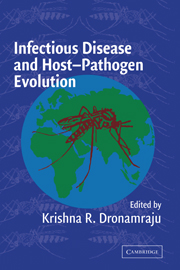Book contents
- Frontmatter
- Contents
- List of Contributors
- Introduction
- PART ONE J. B. S. HALDANE
- PART TWO MALARIAL PARASITES
- PART THREE OTHER PARASITES
- PART FOUR GENETIC AND EVOLUTIONARY CONSIDERATIONS
- 11 The Evolution of Pathogen Virulence in Response to Animal and Public Health Interventions
- 12 Infection and the Diversity of Regulatory DNA
- 13 Genetic Epidemiology of Infectious Diseases: The First Half-Century
- 14 The Impact of Human Genetic Diversity on the Transmission and Severity of Infectious Diseases
- 15 Evolution and the Etiology of Diabetes Mellitus
- 16 The Future of Human Evolution
- Index
- Plate Section
- References
12 - Infection and the Diversity of Regulatory DNA
Published online by Cambridge University Press: 10 August 2009
- Frontmatter
- Contents
- List of Contributors
- Introduction
- PART ONE J. B. S. HALDANE
- PART TWO MALARIAL PARASITES
- PART THREE OTHER PARASITES
- PART FOUR GENETIC AND EVOLUTIONARY CONSIDERATIONS
- 11 The Evolution of Pathogen Virulence in Response to Animal and Public Health Interventions
- 12 Infection and the Diversity of Regulatory DNA
- 13 Genetic Epidemiology of Infectious Diseases: The First Half-Century
- 14 The Impact of Human Genetic Diversity on the Transmission and Severity of Infectious Diseases
- 15 Evolution and the Etiology of Diabetes Mellitus
- 16 The Future of Human Evolution
- Index
- Plate Section
- References
Summary
INTRODUCTION
The importance of regulatory DNA in long-term evolution is well recognized. Major evolutionary advances such as the origin of the bacteria, vertebrates, and mammals can be interpreted largely in terms of regulation of gene expression (1,2). Short-term evolution also is mediated substantially by changes in gene expression, and polymorphism in regulatory DNA provides a major component of genetic variation in natural populations (3–5). Such variation has been particularly well studied in respect to disease susceptibility in human populations, including susceptibility to infection. The immune system is a rich source of regulatory genetic variation, notable in the following four areas:
Inflammation, where variation in the expression of pro- and anti-inflammatory cytokines is conspicuous.
Th1/Th2/Treg balance, where differentiation into distinct T-cell subsets is regulated by the timing and level of gene expression, as can be modeled by Hopff bifurcation (6).
In the constitutive immune system, where multiple copies of, e.g., interferon genes occur.
In the generation of diverse antigen receptor repertoires, where variability among signal sequences mediating V(D)J recombination may regulate ordered assembly and allelic exclusion of the H, β, and δ loci and may bias the preselection repertoire.
In short, the immune system does not know what it will need to cope with next and uses regulatory DNA to provide some of the flexibility needed to function effectively. The same means are also used elsewhere to provide balance and flexibility, e.g., in the cardiovascular system (7).
The problem is that variation is harder to interpret in regulatory than in coding DNA.
- Type
- Chapter
- Information
- Infectious Disease and Host-Pathogen Evolution , pp. 293 - 306Publisher: Cambridge University PressPrint publication year: 2004



